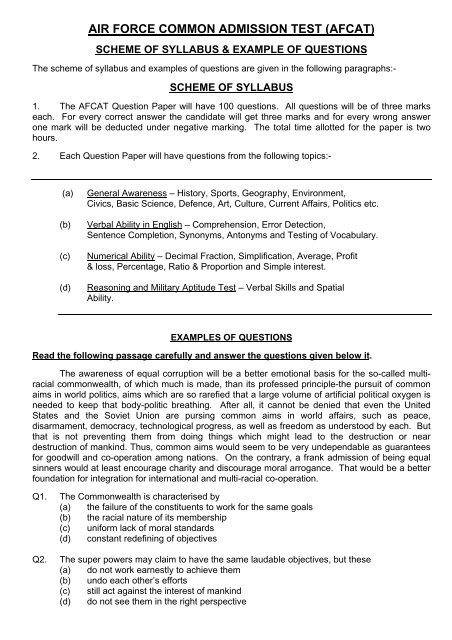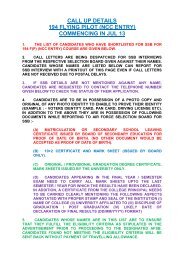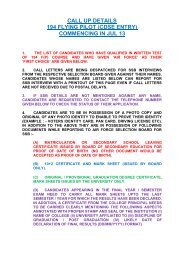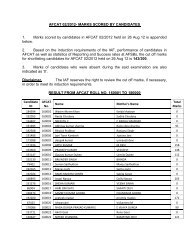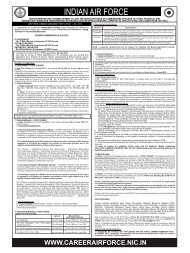AIR FORCE COMMON ADMISSION TEST (AFCAT) - Indian Air Force
AIR FORCE COMMON ADMISSION TEST (AFCAT) - Indian Air Force
AIR FORCE COMMON ADMISSION TEST (AFCAT) - Indian Air Force
You also want an ePaper? Increase the reach of your titles
YUMPU automatically turns print PDFs into web optimized ePapers that Google loves.
<strong>AIR</strong> <strong>FORCE</strong> <strong>COMMON</strong> <strong>ADMISSION</strong> <strong>TEST</strong> (<strong>AFCAT</strong>)<br />
SCHEME OF SYLLABUS & EXAMPLE OF QUESTIONS<br />
The scheme of syllabus and examples of questions are given in the following paragraphs:-<br />
SCHEME OF SYLLABUS<br />
1. The <strong>AFCAT</strong> Question Paper will have 100 questions. All questions will be of three marks<br />
each. For every correct answer the candidate will get three marks and for every wrong answer<br />
one mark will be deducted under negative marking. The total time allotted for the paper is two<br />
hours.<br />
2. Each Question Paper will have questions from the following topics:-<br />
(a) General Awareness – History, Sports, Geography, Environment,<br />
Civics, Basic Science, Defence, Art, Culture, Current Affairs, Politics etc.<br />
(b) Verbal Ability in English – Comprehension, Error Detection,<br />
Sentence Completion, Synonyms, Antonyms and Testing of Vocabulary.<br />
(c) Numerical Ability – Decimal Fraction, Simplification, Average, Profit<br />
& loss, Percentage, Ratio & Proportion and Simple interest.<br />
(d) Reasoning and Military Aptitude Test – Verbal Skills and Spatial<br />
Ability.<br />
EXAMPLES OF QUESTIONS<br />
Read the following passage carefully and answer the questions given below it.<br />
The awareness of equal corruption will be a better emotional basis for the so-called multiracial<br />
commonwealth, of which much is made, than its professed principle-the pursuit of common<br />
aims in world politics, aims which are so rarefied that a large volume of artificial political oxygen is<br />
needed to keep that body-politic breathing. After all, it cannot be denied that even the United<br />
States and the Soviet Union are pursing common aims in world affairs, such as peace,<br />
disarmament, democracy, technological progress, as well as freedom as understood by each. But<br />
that is not preventing them from doing things which might lead to the destruction or near<br />
destruction of mankind. Thus, common aims would seem to be very undependable as guarantees<br />
for goodwill and co-operation among nations. On the contrary, a frank admission of being equal<br />
sinners would at least encourage charity and discourage moral arrogance. That would be a better<br />
foundation for integration for international and multi-racial co-operation.<br />
Q1. The Commonwealth is characterised by<br />
(a) the failure of the constituents to work for the same goals<br />
(b) the racial nature of its membership<br />
(c) uniform lack of moral standards<br />
(d) constant redefining of objectives<br />
Q2. The super powers may claim to have the same laudable objectives, but these<br />
(a) do not work earnestly to achieve them<br />
(b) undo each other’s efforts<br />
(c) still act against the interest of mankind<br />
(d) do not see them in the right perspective
Q3. Common goals are desirable, but these<br />
(a) do not ensure international co-operation<br />
(b) lead to unnecessary tensions<br />
(c) encourage rivalry between super powers<br />
(d) lead to destruction of mankind<br />
Q4. International co-operation can come about if<br />
(a) nations become aware of their own failings and discard pride<br />
(b) charitable organizations are encouraged<br />
(c) different races are treated on the basis of equality<br />
(d) nations guilty of immoral actions are exposed<br />
Q5. The thrust of the author’s argument is that<br />
(a) the Commonwealth has outlived its utility<br />
(b) membership of the Commonwealth be restricted to the super powers<br />
(c) members are equally responsible for the present state of world politics<br />
(d) international peace and co-operation are unattainable.<br />
In each of the following questions, find out which part of the sentence has an error. If there<br />
is no mistake, the answer is (d) “No error”.<br />
Q1 He charged me (a)/one hundred rupees for five dozens(b)/oranges of average quality (c).<br />
No error (d).<br />
(a) (b) (c) (d)<br />
Q2. Raju and his friend (a) /were going to see a picture(b) /when they met his common friend<br />
(c). No error (d).<br />
(a) (b) (c) (d)<br />
Q3. Until you come(a)/ to class regularly (b)/you will fail (c). No error (d)<br />
(a) (b) (c) (d)<br />
Q4. My father is (a)/ in bad mood (b)/ today(c). No error (d)<br />
(a) (b) (c) (d)<br />
Q5. If I was you (a)/ I would not have(b)/ committed this blunder(c). No error(d).<br />
(a) (b) (c) (d)<br />
Pick out the most effective word from the given words to fill in the blank to make the<br />
sentence meaningfully complete.<br />
Q1. Everyone was ________ by surprise when she announced her plan to marry that man.<br />
(a) moved (b) shaken (c) taken (d) disturbed<br />
Q2. She always insisted on the need to ____ between ends and means.<br />
(a) analyse (b) define (c) distribute (d) distinguish<br />
Q3. He_____ that he would come.<br />
(a) requested (b) said (c) pleaded (d) urged<br />
Q4. He had good ____ over the ancient languages, too.<br />
(a) authority (b) knowledge (c) command (d) expertise<br />
Q5. Around the head of the running man there was a _______ of bees.<br />
(a) crowd (b) group (c) flock (d) swarm
In each of the following choose the word most similar in meaning to the word given in<br />
capitals.<br />
Q1. UNDULATE<br />
(a) retard (b) decrease (c) wave (d) flood<br />
Q2. MYOPIC<br />
(a) blind (b) astigmatic (c) cross-eyed (d) short-sighted<br />
Q3. ERUDITE<br />
(a) strong (b) precious (c) learned (d) courteous<br />
Pick out the word that is most nearly the opposite in meaning to the word given in capitals.<br />
Q1. RELINQUISH<br />
(a) accept (b) retain (c) gain (d) revive<br />
Q2. TURBULENT<br />
(a) turbid (b) violent (c) steady (d) turgid<br />
Q3. ERRATIC<br />
(a) regular (b) right (c) free (d) rapid<br />
Choose the correct answer.<br />
General Awareness<br />
Q.1 Name the first person who went in the space<br />
(a) Yuri Gangarin (b) Neil Armstrong<br />
(c) Rakesh Sharma (d) John Glann<br />
Q2. The first <strong>Indian</strong> woman who won a medal in Olympic is-<br />
(a) PT Usha (b) Shiny Abraham<br />
(c) Dala Banerjee (d) Karram Malleswari<br />
Q3. The cricketer who scored the first double century in one day cricket match is-<br />
(a) Vivian Richards (b) Brain Lara<br />
(c) Ricky Ponting (d) Sachin Tendulkar<br />
Q4. Lionel Messy is associated with the game of—<br />
(a) Rugby (b) Tennis (c) Football (d) Basketball<br />
Q5. The instrument of measuring intensity of earthquakes is called-<br />
(a) Ediograph (b) Pantagraph (c) Ergograph (d) Seismograph<br />
Numerical Ability<br />
Q1. When simplified (2.43 x 2.43 + 2.43 x7.57 x 2 + 7.57 x 7.57) is equal to-<br />
(a) 10 (b) 100 (c) 101.89 (d) 200.59<br />
Q2. The sum of ` 6.25 is made up of 80 coins which is either ten paise and five paise. The<br />
number of five paise coins are-<br />
(a) 25 (b) 35 (c) 40 (d) 45
Q3. Three years ago the average age of A & B was 18 years. With C joining them now, the<br />
average age becomes 22 years. How old is she?<br />
(a) 24 years (b) 27 years (c) 28 years (d) 30 years<br />
Q4. The average age of 8 men is increased by 2 years when two of them whose ages are 21<br />
years and 23 years are replaced by two new men. The average age of the two new men is-<br />
(a) 22 years (b) 24 years (c) 28 years (d) 30 years<br />
Q5. Amit sold an umbrella for ` 680, losing 15%. The cost price of the umbrella is-<br />
(a) ` 782 (b) ` 800 (c) ` 578 (d) None of these<br />
Reasoning and Aptitude Tests<br />
This is a test of your ability to understand words. For each question in the test there are four<br />
possible answers: A, B, C, or D. There is only one correct answer for each question. Read each<br />
question carefully and decide which one of the four answers is the best one. Mark your answer on<br />
the answer sheet by blacking out the letter that corresponds to your choice.<br />
Now look at the example questions below:<br />
Q1. MAN is to BOY as WOMAN is to<br />
(A) BABY<br />
(B) BRIDE<br />
(C) CHILD<br />
(D) GIRL<br />
Answer - D<br />
Q2. WATER is to THIRST as FOOD is to<br />
(A) FAMINE<br />
(B) GRIEF<br />
(C) HUNGER<br />
(D) INDIGESTION Answer - C<br />
In these questions, choose the word from the four alternatives (1), (2), (3) and (4) that is most<br />
nearly similar in meaning to the word given in CAPITAL letters.<br />
Q1. REVULSION<br />
(1) Apathy (2) Violence<br />
(3) Disgust (4) Avenge<br />
Answer - 3<br />
Analogy<br />
In the following questions there is a pair of capitalized words followed by four choices marked A, B,<br />
C, D. Choose the pair of words whose relationship is most similar to that expressed by the<br />
capitalized pair, and mark your choice on your answer sheet.<br />
Q1. COLD : HOT<br />
A handsome : young B beautiful : ugly<br />
C summer : spring D complete : total<br />
Answer – B
Spatial Ability<br />
This is a test of your ability to recognize a form from its pattern, or a pattern from its form. Now<br />
look at the example questions below. There is a problem you are to find the form that can be made<br />
by folding the cardboard pattern and fitting it together.<br />
Answer - Last<br />
ROTATED BLOCKS<br />
This subtest is designed to test your ability to visualize and manipulate objects in space. In each<br />
question, you will be shown a picture of a block. To the right of the pictured block are five choices,<br />
each showing a different block. You are required to select the choice containing a block that is just<br />
like the pictured block at the left although turned in a different position. In order to arrive at the<br />
correct answer, you may have to mentally turn blocks over, turn them around, or turn them both<br />
over and around.<br />
The correct answer is D.<br />
HIDDEN FIGURES<br />
This test is designed to measure your ability to see simple figures in complex drawings. Although<br />
these figures are fairly well camouflaged, proper visualization should enable you to discern them<br />
without too much difficulty.<br />
At the top of each section of this subtest are five figures lettered A, B, C, D, and E. Below these on<br />
each page are several numbered drawings. You must determine which lettered figure is contained<br />
in each of the numbered drawings.
The correct answer is (B).<br />
Problem Solving<br />
Q1.What number should come next in the sequence?<br />
3 6 12 24 48<br />
Answer = 96 (progressions are doubling each time)<br />
Q2. Empty is to full as wet is to?<br />
a. damp b. soaked c. dry d. water e. rain<br />
Answer = c. dry<br />
Rotated Blocks<br />
In the Block Rotation subtest, you will see blocks of different shapes, with cubes, cylinders, and other objects on them.<br />
In the examples below, you see six images. The image in the upper left-hand corner shows the model block. One of<br />
the five images labeled A through E also shows the model block, but rotated in space. The remaining images show a<br />
different block, rotated to various positions in space. Your task is to choose from the images labeled A through E the<br />
image that shows the model block rotated in space.<br />
Item 1=A


